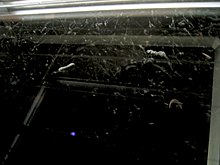Particle detector

A particle detector is a component or measuring device for detecting free, moving molecules , atoms or elementary particles . Since particles with very different properties are detected with particle detectors , there are many different particle and radiation detectors with different operating principles. With most detectors, the particles hitting them are registered as individual events; the mean number of events per unit of time is then called the count rate .
Proof of electromagnetic interaction with matter
Gas-filled ionization detectors

- Ionization chamber : Here the electrical charge generated by ionizing radiation is measured either as individual current pulses or, in some applications, as an integrated current.
- Proportional counter
- Geiger-Müller counter tube : Counts individual ionizing particles regardless of their type and energy. Suitable for different particles depending on the structure (entry window) and filling gas
- Spark counter (streamer chamber)
- Multi-wire proportional chamber (short wire chamber, Eng. Multi-wire proportional chamber , MWPC)
- Time projection chamber (Engl. Time projection chamber TPC)
- Resistive plate chamber (Engl. Resistive plate chamber , RPC)
-
Microstructured gas detectors (. English micro-pattern gas detector , MPGD) achieved by reducing the read-out structures better spatial resolution than 'conventional' gas detectors and therefore represent an active area of research fall Below.:
- Gas Electron Multiplier (short: GEM)
- MicroMegas (English for micromesh gaseous structure )
Semiconductor detectors
In semiconductor detectors , ionizing radiation generates free electrical charges similar to that in ionization chambers (see above). These pulses are amplified by appropriate circuitry (for example transistors) which can be assembled directly with the detector.
Scintillation detectors
The scintillation detector is a detector that uses the property of various materials to convert the excitation generated when ionizing particles pass through it into light. The light produced is a function of the energy given off by the particle. The resulting flash of light is detected , for example, with a photocell with a downstream secondary electron multiplier.
Lane detectors
Cherenkov detectors
A Cherenkov detector is a detector that uses the Cherenkov effect to detect particles. There are different versions, from measuring whether light is being emitted (threshold detector) to determining the direction and opening angle of the light cone ( e.g. RICH and DIRC).
Cherenkov detectors can be very large and are therefore suitable as neutrino detectors .
Further procedures
- Transition radiation detector (engl. Transition Radiation Detector, short TRD): These detectors typically consist of a stack of sheets perpendicularly to the direction of Teilchendurchgangs. By detecting transition radiation , it is possible to identify the particles passing through.
- Particle detectors that detect slow electrons or ions: The particles release one or more electrons in a suitable surface , these are multiplied in a secondary electron multiplier ( e.g. Channeltron ) and detected
- Electromagnetic calorimeter
Detection of uncharged particles
-
Neutron detectors :
- Fast neutrons are detected via elastically impacted charged particles (mostly protons ).
- Slow and thermal neutrons are detected by suitable nuclear reactions (for example with 10 boron ) and detection of the resulting charged particles.
- Neutrino detectors
- Hadronic calorimeter
- Phase transition thermometer
Detector telescope
In experimental nuclear physics, a telescope is an arrangement of two or more detectors that are located one behind the other at a certain distance. The name is not intended to indicate a magnification function as in optical telescopes, but was chosen because of the external similarity to the lenses of a telescope lens . The detectors are operated in coincidence , which means that a particle is only registered if it causes pulses in both or all detectors. To do this, the particle must penetrate the detectors (except for the last one), so its range in the detector material must be greater than the combined thickness of these detectors. If the energy of the particle is to be measured, the rearmost detector must be thick enough to stop the particle.
The purpose of the telescope arrangement can be to select the direction, for example in order to exclude non-interesting particles falling from the side.
Another application is the differentiation of charged particle types, such as protons and alpha particles, based on their different braking capacities . In a telescope made up of two semiconductor detectors (formerly also proportional counters), the front, thin detector registers a fraction of the particle energy , the rear, thick detector the remaining energy . The particle energy results from the sum of the two pulse heights; at the same time the ratio gives information about the type of particle.
These two functions of the telescope arrangement are also important for the composite detectors of high-energy physics, for neutrino telescopes , etc.
Detectors in high energy physics
In experiments in high-energy physics , i.e. experimental particle physics , a detector is usually a combination of many individual detectors of the same or different types. This is useful and necessary because the particles to be observed have long ranges in matter and because many particles from one and the same collision process have to be identified and measured at the same time. Examples are the ATLAS , ALICE , and Compact Muon Solenoid detectors at what is currently the largest accelerator facility, the Large Hadron Collider .
literature
- Glenn F. Knoll: Radiation detection and measurement. 2nd ed. New York: Wiley, 1989. ISBN 0-471-81504-7 .
- C. Grupen: particle detectors , spectrum academ. Verlag, 1993, ISBN 978-3411165711 .
- WR Leo: Techniques for Nuclear and Particle Physics Experiments , Springer-Verlag, 1987, ISBN 3-540-17386-2 .
- K. Kleinknecht: Detectors for particle radiation . 4th edition, Teubner 2005, ISBN 978-3-8351-0058-9 .





